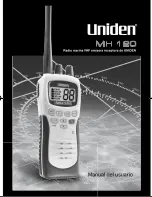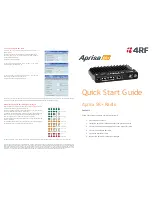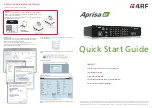
the control from the CPU, it passes in the compandor circuit
inside of
Q1021
(
LA8630M
) and it is output and it passes a
pre-emphasis circuit.
Q1063
(
BU4066BCFV
) becomes “OFF”
when an option unit is attached and the AF signal from
Q1037
(
AK2345
) goes via the option unit. When an option unit isn’t
attached,
Q1063
(
BU4066BCFV
) becomes “ON,” the signal
passes
Q1063
(
BU4066BCFV
) and is input to
Q1037
(
AK2345
). The signal passed limiter and splatter filer of
Q1037
(
AK2345
) is adjusted by maximum deviation adjustment vol-
ume
Q1029
(
M62364FP
). The adjusted low frequency signal
ingredient is amplified by
Q1074
(
NJM12902V
), added modu-
lation terminal of TCXO (
X1003
), the FM modulation is made
by reference oscillator. The high frequency signal ingredient is
amplified
Q1074
(
NJM12902V
), and adjusted the level by
volume
Q1029
(
M62364FP
) to make frequency balance be-
tween low frequency. After that, it is made FM modulation to
transmit carrier by the modulator
D1030
(
HVC383B
) of VCO.
3-2. Drive and Final amplifier
The modulated signal from the VCO
Q1054
(
2SK508
) is buff-
ered by
Q1049
(
2SC5226
) and amplified by
Q1038
and
Q1002
(both
2SC5226
). The low-level transmit signal is then applied
to the Power Module
Q1028
(
S-AV32
) for final amplification
up to 50 watts output power. The transmit signal then passes
through the antenna switch
D1006
(
UM9957F
) and is low-pass
filtered to suppress away harmonic spurious radiation before
delivery to the antenna.
3-3. Automatic Transmit Power Control
The output power of Power Module is detected by CM coupler,
it is detected by
D1013
and
D1014
(both
HSM88AS
) and is
input to comparator
Q1090
(
NJM12902V
). The comparetor
compares two different voltages and makes output power stable
by controlling the bias voltage of Power Module. There are 3
levels of output power (Hi, Mid and Lo), it is switched by the
voltage of
Q1029-1
(
M62364FP
).
3-4. PLL Frequency Synthesizer
The frequency synthesizer consists of PLL IC
Q1085
(
SK7025DK
),
Q1045
(
DTC114TE
), VCO, TCXO (
X1003
)
and buffer amplifier. The output frequency from TCXO is 16.8
MHz and the tolerance is ±2.5 ppm (in the temperature range -
30 to +60 degrees).
3-4-1. VCO
While the radio is receiving, the RX oscillator
Q1054
(
2SK508
)
in VCO generates a programmed frequency between 184.85
and 224.85 MHz as 1st local signal. While the radio is transmit-
ting, the TX oscillator
Q1058
(
2SC3356
) in VCO generates a
frequency between 134 and 174 MHz. The output from oscilla-
tor is amplified by buffer amplifier
Q1049
(
2SC5226
) and be-
comes output of VCO. The output from VCO is divided, one is
amplified by
Q1057
(
2SC5226
) and feed back to pin 5 of the
PLL IC
Q1085
(
SK7025DK
). The other is amplified in
Q1038
(
2SC5226
) and in case of the reception, it is put into the mixer
as the 1st local signal through
D1022
(
DA221
), in transmis-
sion, it is amplified in
Q1038
(
2SC5226
), and more amplified
in
Q1002
(
2SC5226
) through
D1022
(
DA221
) and it is put
the input terminal of the Power Module
Q1028
(
S-AV32
).
3-4-2. VCV CNTL
Tuning voltage (VCV) of VCO is expanding the lock range of
VCO by controlling the anode of varactor diode at the negative
voltage and the control voltage from PLL IC
Q1085
(
SK7025DK
). The negative voltage is added to the varactor
diode after converted to negative by
Q1035
(
SPM5001
), which
is output voltage of D/A converter
Q1029
(
M62364FP
).
3-4-3. PLL
The PLL IC
Q1085
(
SK7025DK
) consists of reference divider,
main divider, phase detector, charge pumps and fractional ac-
cumulator. The reference frequency from TCXO is inputted to
pin 8 of PLL IC
Q1085
(
SK7025DK
) and is divided by refer-
ence divider. This IC is decimal point dividing PLL IC
Q1085
(
SK7025DK
) and the dividing ratio becomes 1/8 of usual PLL
frequency step. Therefore, the output of reference divider is 8
times of frequencies of the channel step. For example, when
the channel stepping is 5 kHz, the output of reference divider
becomes 40 kHz. The other hand, inputted feed back signal to
pin 5 of PLL IC
Q1085
(
SK7025DK
) from VCO is divided
with the dividing ratio which becomes same frequency as the
output of reference divider. These two signals are compared by
phase detector, the phase difference pulse is generated. The phase
difference pulse and the pulse from fractional accumulator pass
through the charge pumps and LPF. It becomes the DC voltage
(VCV) to control the VCO. The oscillation frequency of VCO
is locked by the control of this DC voltage. The PLL serial data
from CPU
Q1083
(
LC87F74C8A
) is sent with three lines of
SDO (pin 2), SCK (pin 1) and PSTB (pin 3). The lock condi-
tion of PLL is output from the UL (pin 18) terminal and UL
becomes “H” at the time of the lock condition and becomes “L”
at the time of the unlocked condition. The CPU
Q1083
(
LC87F74C8A
) always watches over the UL condition, and
when it becomes “L” unlocked condition, the CPU
Q1083
(
LC87F74C8A
) prohibits transmitting and receiving.
Circuit Description
E-2
Содержание VX-4100 Series
Страница 4: ...Note B 2 ...
Страница 7: ...D 1 Block Diagram RF Unit ...
Страница 8: ...D 2 Block Diagram FRONT C Unit VX 4100 FRONT D Unit VX 4200 ...
Страница 14: ...Installation of Option Note G 2 ...
Страница 16: ...RF Unit Lot 1 H 2 Note ...
Страница 19: ...RF Unit Lot 2 H 5 Circuit Diagram ...
Страница 20: ...RF Unit Lot 2 H 6 Note ...
Страница 23: ...RF Unit Lot 3 5 H 9 Circuit Diagram ...
Страница 24: ...RF Unit Lot 3 5 H 10 Note ...
Страница 27: ...RF Unit Lot 6 H 13 Circuit Diagram ...
Страница 28: ...RF Unit Lot 6 H 14 Note ...
Страница 47: ...I 3 FRONT C Unit VX 4100 Lot 6 Circuit Diagram ...
Страница 53: ...J 3 FRONT D Unit VX 4200 Lot 6 Circuit Diagram ...
Страница 59: ...L 1 DVS 5 Voice Storage Unit Option Circuit Diagram ...











































